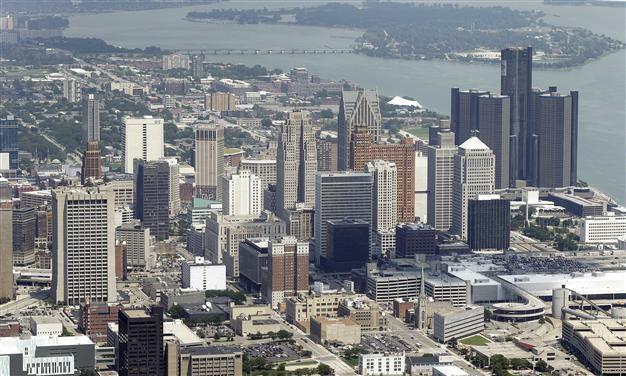Detroit becomes largest US city to file for bankruptcy
DETROIT, Michigan - Agence France-Presse

In this July 17, 2013, aerial photo is the city of Detroit. On Thursday, July 18, 2013, Detroit became the largest city in U.S. history to file for bankruptcy when State-appointed emergency manager Kevyn Orr asked a federal judge for municipal bankruptcy protection. AP Photo/Paul Sancya
Detroit on Thursday became the largest city in US history to file for bankruptcy protection after decades of decline and mismanagement rendered the home of the nation's auto industry insolvent.Once a bustling beacon of industrial might, the city is now a poster child for urban decay, its landscape littered with abandoned skyscrapers, factories and homes.
Crime is rampant, and the city literally cannot afford to keep the lights on -- a whopping 40 percent of streetlights are out.
Detroit's bankruptcy is expected to make it harder for municipalities in Michigan and other US states to borrow money by undermining confidence in what used to be among the most trusted bonds available.
Michigan Governor Rick Snyder said there was no other option. "This is a difficult step, but the only viable option to address a problem that has been six decades in the making," Snyder said in a press release.
Detroit has seen its population shrink by more than half, from 1.8 million people in 1950 to 700,000 today.
Racial tensions sparked by the civil rights movement -- and the devastating 1967 riots -- exacerbated white and middle-class flight to the suburbs. Businesses followed suit, further shrinking the tax base.
With less revenue, Detroit had to cut back on services, prompting even more people to leave and eventually sending the city into an economic tailspin.
The Motor City meanwhile saw its main employers go through round after round of mass layoffs as auto factories were automated or outsourced and Asian competitors siphoned away market share.
"The citizens of Detroit need and deserve a clear road out of the cycle of ever-decreasing services," Snyder said in a letter accompanying the court filing.
"The only feasible path to a stable and solid Detroit is to file for bankruptcy protection." Earlier this year Snyder appointed an emergency manager with a background in bankruptcy to restructure the city's finances.
He said he had "very much hoped" the move would help Detroit avoid bankruptcy, but that now it is time to "face the fact that the City cannot and is not paying its debts as they become due and is insolvent." The White House said President Barack Obama is closely monitoring the situation.
"While leaders on the ground in Michigan and the city's creditors understand that they must find a solution to Detroit's serious financial challenge, we remain committed to continuing our strong partnership with Detroit as it works to recover and revitalize and maintain its status as one of America's great cities," White House spokeswoman Amy Brundage said.
Detroit stopped making payments on some of its $18.5 billion of debt and obligations last month as the emergency manager sought relief from creditors.
But the city's employee pension plans -- which are owed some nine billion dollars -- filed a lawsuit to prevent any cuts to retirement benefits.
The bankruptcy filing places that case on hold and comes days before what could have been a key hearing.
It will be up to a federal judge to determine if Detroit is allowed to restructure -- and even shed -- its obligations in a Chapter 9 bankruptcy.
"You can expect challenges right out of the box," said bankruptcy lawyer Douglas Bernstein of Michigan-based Plunkett Cooney.
Unlike General Motors and Chrysler -- which were able to restructure under bankruptcy protection in 2009 in a matter of weeks thanks to the backing of the US government -- it could take years for Detroit's case to be resolved, Bernstein warned.
"One of the biggest challenges is that there haven't been very many municipal bankruptcies in the history of the bankruptcy code, so there's not a lot of guidance," Bernstein told AFP.
Snyder listed a host of problems to illustrate why Detroit cannot meet its obligations to its citizens while weighed down by debt.
The homicide rate is the highest in nearly 40 years and, for more than two decades, Detroit has been on the list of the most dangerous cities in the United States.
People have to wait an average of 58 minutes for the police to respond to their calls, compared to an average of 11 minutes nationwide.
There are 78,000 abandoned buildings scattered across the city and a lack of funds for maintenance and repairs means only a third of the city's ambulances work.
The city has been borrowing money to pay its bills for more than a decade, a short-sighted move that further depleted its coffers. Some 38 cents of every city dollar was going to debt repayment and obligations like pensions, and that was projected to hit 65 cents on the dollar by 2017.
















